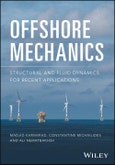Covers theoretical concepts in offshore mechanics with consideration to new applications, including offshore wind farms, ocean energy devices, aquaculture, floating bridges, and submerged tunnels
This comprehensive book covers important aspects of the required analysis and design of offshore structures and systems and the fundamental background material for offshore engineering. Whereas most of the books currently available in the field use traditional oil, gas, and ship industry examples in order to explain the fundamentals in offshore mechanics, this book uses more recent applications, including recent fixed-bottom and floating offshore platforms, ocean energy structures and systems such as wind turbines, wave energy converters, tidal turbines and hybrid marine platforms.
Offshore Mechanics covers traditional and more recent methodologies used in offshore structure modelling (including SPH and hydroelasticity models). It also examines numerical techniques, including computational fluid dynamics and finite element method. Additionally, the book features easy-to-understand exercises and examples.
- Provides a comprehensive treatment for the case of recent applications in offshore mechanics for researchers and engineers
- Presents the subject of computational fluid dynamics (CFD) and finite element methods (FEM) along with the high fidelity numerical analysis of recent applications in offshore mechanics
- Offers insight into the philosophy and power of numerical simulations and an understanding of the mathematical nature of the fluid and structural dynamics with focus on offshore mechanic applications
Offshore Mechanics: Structural and Fluid Dynamics for Recent Applications is an important book for graduate and senior undergraduate students in offshore engineering and for offshore engineers and researchers in the offshore industry.
Table of Contents
About the Authors ix
Preface xi
Acknowledgements xiii
1 Preliminaries 1
2 Offshore Structures 7
2.1 ShipÂ]shaped Offshore Structures 7
2.2 Oil and Gas Offshore Platforms 10
2.3 Offshore Wind Turbines 13
2.4 Wave Energy Converters 22
2.5 Tidal Energy Converters 28
2.6 Combined Offshore Energy Systems 32
2.7 Multipurpose Offshore Structures and Systems 35
2.8 Submerged Floating Tunnels 36
2.9 Floating Bridges 39
2.10 Aquaculture and Fish Farms 42
References 44
3 Offshore Environmental Conditions 51
3.1 Introduction 51
3.2 Wave Conditions 51
3.2.1 Basic Characteristics of Free Surface Normal Waves 52
3.2.2 Swells 54
3.2.3 Wave Propagation in Space 54
3.2.4 Wave Measurement 55
3.3 Wind 55
3.3.1 Global Wind Pattern 55
3.3.2 Wind Measurement 57
3.4 Currents 58
3.4.1 Tidal Currents 58
3.4.2 WindÂ]driven Currents 59
3.4.2.1 Global WindÂ]driven Currents 59
3.4.2.2 Longshore Currents 59
3.4.2.3 Rip Currents 59
3.4.2.4 Upwelling Currents 60
3.5 Joint Distribution of Waves and Winds 61
3.6 Oceanographic and Bathymetric Aspects 68
3.7 Scour and Erosion 71
3.8 Extreme Environmental Conditions 75
3.9 Environmental Impact of Offshore Structures’ Application 79
References 82
4 Hydrodynamic and Aerodynamic Analyses of Offshore Structures 87
4.1 Introduction 87
4.2 Wave Kinematics 87
4.2.1 Regular Waves 87
4.2.2 Ocean Waves 92
4.3 Wave Loads on Offshore Structures 95
4.3.1 Wave Loads Induced by Inviscid Flows 97
4.3.1.1 Inviscid Loads Due to Forced Oscillation of an Offshore Structure (Concept of Added Mass and Damping Coefficients) 99
4.3.1.2 Added Mass and Damping Coefficients in the Presence of a Free Surface 102
4.3.1.3 Considering Diffraction Effects on Calculating Wave Loads 104
4.3.2 Morison Equation 106
4.4 Tides and Currents Kinematics 107
4.5 Current Loads on Offshore Structures 109
4.6 Wind Kinematics 110
4.6.1 Wind Data Analysis 111
4.6.2 Extreme Wind Conditions 113
4.6.3 Wind Speed Variation with Height 114
4.7 Wind Loads on Offshore Structures 115
4.8 Aerodynamic Analysis of Offshore Wind Turbines 117
4.8.1 1D Momentum Theory 117
4.8.2 Effects of Wind Turbine Rotation on Wind Thrust Force 119
4.8.3 Blade Element Momentum Theory 121
References 124
5 Fundamentals of Structural Analysis 127
5.1 Background 127
5.1.1 Structural Components 128
5.1.2 Stress and Strain 134
5.2 Structural Analysis of Beams 139
5.2.1 Introduction 139
5.2.2 Beams under Torsion 141
5.2.3 Bending of Beams 147
5.2.4 Beam Deflections 152
5.2.5 Buckling of Beams 155
5.3 Mathematical Models for Structural Dynamics of Beams 159
5.3.1 Bernoulli–Euler Beam Theory 161
5.4 Frame Structures and Matrix Analysis 166
5.5 Plate Theories 172
5.5.1 Introduction 172
5.5.2 Plane Stress 174
5.5.3 Mathematical Models for Bending of Plates 176
References 178
6 Numerical Methods in Offshore Structural Mechanics 183
6.1 Structural Dynamics 183
6.2 Stress Analysis 188
6.3 TimeÂ]Domain and FrequencyÂ]Domain Analysis 189
6.4 Multibody Approach 197
6.5 Finite Element Method 199
6.6 Nonlinear Analysis 199
6.7 Extreme Response Analysis and Prediction 201
6.8 Testing and Validation of Offshore Structures 204
6.9 Examples 211
6.9.1 Example 6.1 211
6.9.2 Example 6.2 213
References 214
7 Numerical Methods in Offshore Fluid Mechanics 217
7.1 Introduction 217
7.2 Potential Flow Theory Approach 217
7.2.1 ThreeÂ]dimensional Problem 222
7.2.2 Numerical Consideration 224
7.3 CFD Approach 225
7.3.1 Discretization of the Navier–Stokes Equation on Rectangular Structured Grids 226
7.3.2 Advection Terms 227
7.3.3 Viscous Terms 228
7.3.4 Pressure Term and Mass Conservation Equation 228
7.3.5 Solving Navier–Stokes Equations 229
7.3.6 Poisson Equation 230
7.3.7 The Effects of Free Surface 233
7.3.8 Volume of Fluid Method 234
7.3.9 Level Set Method 236
7.3.10 Discretization of Level Set Function 237
7.3.11 Discretization of Reinitialization Equation 240
7.3.12 Studying Solid–Fluid Interaction 241
7.3.13 Immersed Boundary Methods 242
7.3.14 Discretization of the NS Equation in a Mapped Coordinate System 244
7.3.15 Grid Generation in a Mapped Coordinate System: Stretched Grid 248
7.3.16 Grid Generation in the Mapped Coordinate System: BodyÂ]Fitted Grids 249
7.3.17 BodyÂ]Fitted Grid Generation by Using Unstructured Grids 251
References 252
8 Mooring and Foundation Analysis 255
8.1 Mooring Considerations 255
8.1.1 Catenary Moorings 261
8.1.2 Taut Moorings 263
8.2 Soil Mechanics 267
8.3 Foundation Design 275
References 285
Index 287








